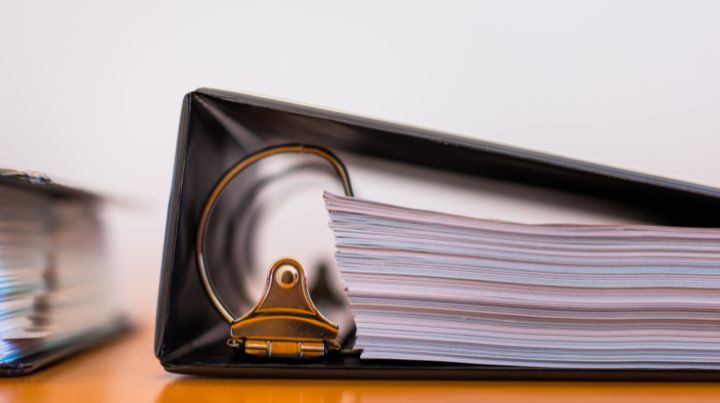Building an Emergency Document Binder: What It Is and What to Include

In an emergency, losing important documents would complicate a stressful situation. It doesn't even have to be a natural disaster: in a sudden emergency such as a fire, evacuation, medical emergency, or financial emergency, having all your critical information in one place can help you act more efficiently and thoroughly. A great way to prepare for an unforeseen crisis is to create an emergency document binder containing the essential documents you and your family might need in an emergency.
Let's look at what it is and how to organize one efficiently.
What is an Emergency Document Binder?
An emergency document binder is a collection of all your important personal, financial, and medical documents stored in an easily accessible location. The binder should include copies of essential documents that can help you get assistance or rebuild your life in case of disaster or emergencies. This may include personal identification, insurance policies, medical records, financial statements, etc. Many people store documents in a filing cabinet or their home office, but it usually takes time to get them all together. In an emergency, you'll need to be able to grab your documents when you have just minutes to spare. Or, in the event of a sudden illness, you'll need to be able to direct your family to where you keep your financial, medical, or legal information.
When Do You Need an Emergency Document Binder?
1. Disaster Preparedness
You may need to evacuate your home quickly during natural disasters such as hurricanes, earthquakes, or wildfires. If you need to leave the house quickly, you may only have minutes to gather what's important. An emergency binder lets you have your crucial documents ready so you won't lose time searching for paperwork.
2. Financial Security
I was recently in a situation where I thought I would be getting laid off from my job. First, I looked at financial records to see how long I could manage my bills without a paycheck. In the event you lose your job, having your financial records organized can make managing your situation far easier. Another situation is having to file an insurance claim after a flood. It would be a lot more convenient to have insurance and bank information at your fingertips than having to search for them.
3. Health and Medical Emergencies
No one can foresee having accidents or medical emergencies. If you end up in a hospital, having a binder that contains your medical records, health insurance information, and emergency contacts will help you deal with healthcare providers and claims.
4. Legal Protection
Finally, it's a good idea to have backup copies of your legal documents, such as wills, power of attorney forms, and titles, which are often irreplaceable. Storing copies of these documents in an emergency binder ensures you can act quickly if legal action is needed in case you are incapacitated or unavailable.
What to Include in Your Emergency Document Binder
To build a comprehensive emergency document binder, start gathering documents covering different aspects of your life. Each family will have a different set of documents, depending on their circumstances. Here are some ideas on what to include.
1. Personal Identification Documents
These documents will help you prove your identity and citizenship.
- Copies of passports
- Birth certificates
- Social Security cards
- Driver's licenses or state IDs
- Marriage certificates
- Adoption or guardianship papers (if applicable)
- Military records (if applicable)
- Naturalization or immigration papers
2. Medical Information
It's good to have detailed medical records, particularly for persons with chronic conditions or life-threatening allergies.
- Health insurance policies and cards
- Medicare/Medicaid documents (if applicable)
- List of allergies or medical conditions for each family member
- List of medications, dosages, and prescription information
- Medical history summaries
- Immunization records
- Living wills or medical directives
- Contact information for primary care doctors and specialists
3. Financial and Insurance Documents
These documents can be critical during disasters where you may need to file insurance claims, access emergency funds, or protect your assets.
- Homeowners, renters, and auto insurance policies
- Life insurance policies
- Health insurance policies
- Property deeds and mortgage statements
- Vehicle titles and loan agreements
- Recent tax returns (last 2-3 years)
- Retirement account information (401(k), IRA)
- Bank account numbers and contact information
- Investment account information
- Credit card information and emergency numbers
- Emergency cash (small bills and coins)
4. Legal Documents
Legal papers are often hard to replace, so storing copies in your emergency binder is essential.
- Last Will and Testament
- Power of attorney forms (medical and financial)
- Trust documents
- Custody agreements
- Property deeds
- Business ownership documents
- Divorce decrees or separation agreements
- Child support or alimony records
5. Emergency Contacts and Communication Plans
Include a contact list of key individuals and organizations.
- Emergency contacts (family members, close friends)
- Work contact information
- School contacts (if applicable)
- Local emergency services
- Pet information (vet contact, vaccination records)
- Neighbors or trusted people who can assist
6. Other Important Documents
These are miscellaneous documents that may be helpful in an emergency.
- Pet records (vaccination records, adoption papers)
- Utility and service provider information
- Evacuation routes and meeting points
- Copies of house keys
- Backup flash drive with digital copies of all documents

How to Organize Your Emergency Document Binder
1. Use Tabs
Divide your binder into separate sections with labels such as “Identification,” “Medical,” “Insurance,” etc. This makes it easier to find the document you need quickly. I also like to use sheet protectors for each document to keep them safe from damage.
2. Create Copies
Create copies of original documents and keep copies in your emergency binder. Consider having another set of copies in a safe deposit box or a separate, secure place such as a trusted relative. Keep the originals in a safe place as well.
3. Keep Digital Backups
In addition to physical copies, create digital copies of each document and store them on an encrypted USB drive or in a secure cloud storage service. This is helpful if your physical binder is damaged or lost.
4. Review and Update Regularly
Review your emergency binder and update it regularly to reflect changes. Set a reminder in your calendar to review the binder every six months or every year to ensure all documents are current, especially financial and insurance records.
5. Waterproof and Fireproof Storage
Consider storing your binder in a waterproof and fireproof safe or storage box. As an extra precaution, consider including a small emergency kit with items like a flashlight, batteries, and other supplies that could be useful during a disaster.
Conclusion
Building an emergency document is a low-cost project to help you prepare for the unexpected. Having a well-organized and detailed set of documents brings you peace of mind, knowing you can handle any emergency with a well-organized set of critical records.
Additional Resources:
- The Death File
- Maintenance Logs For Preppers
- What Should Preppers Have in Their Winter Emergency Kit?
- Home Fire Safety and Preparedness
Related Articles
FREE Guide
Read the Best Seller
Join Mind4Survival
Stay informed by joining the Mind4Survival! 100% Secure! 0% Spam!
Affiliate Disclosure...
Mind4Survival is a free, reader-supported information resource. If you make a purchase through our link, we may, at no cost to you, receive an affiliate commission.
Do You Want To Be Ready No Matter What?

Download our free 39-page guide with interactive, 7-Day Emergency Kit Checklist and take the first step toward real preparedness.
- Know exactly where to start.
- Save time and money.
- How-to build a complete Basic Emergency Kit.
- Level up your safety and security.
Join Mind4Survival
Stay informed by joining the Mind4Survival! 100% Secure! 0% Spam!






